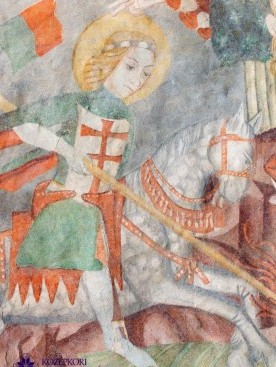The Calvinist Church – TarpaThe village was mentioned for the first time in 1299, and in 1322 its church dedicated to Saint Andrew had already been built. Tarpa was a market town (oppidum) in the Middle Ages. One part of the settlement was called Tarpasziget. According to historical sources, the Order of Saint Paul the First Hermit built a monastery there. The church in Tarpa is the largest in the Bereg region, being larger in size than all the other medieval churches. The single structural element remaining from this large medieval church are the walls made of volcanic blocks of stone, which belonged to the nave. It is unclear, whether the present church is identical with the one mentioned at the beginning of the 14h century, or it was built after the demolition of the first church as its replacement at the end of the 14th and the beginning of the 15th century. Only the western and southern gate, leading to the narthex have been preserved. The latter gate was decorated with a billet and canopies supported its lintel on each side. During the refurbishment of the church, in the 18th century, the Gothic style widows were enlarged. Above the southern gate, there is a slab decorated with the coat of arms of the Bátori family. This is surrounded by the symbol of the Order of the Dragons (Societas Draconistrarum). The 7 centimetres thick door is the original medieval one, just like the iron elements on it and its locking mechanism. Such kind of works of art, created by cabinet-makers during the Gothic period and being preserved in an intact state are very rare in Hungary. The congregation adopted the Calvinist faith by the middle of the 16th century. In 1795, a huge aisle-less church having the same width as the medieval nave was built, and a 45.5 metres high tower erected on its eastern side. In 1881, a powerful lightning hit the tower and split the bells into pieces. The special attractions of this church are the medieval mural paintings created at the beginning of the 15th century. The first and largest painting shows Saint George fighting the Dragon, an important scene in what concerns Hungarian art history. Saint George was venerated in Hungary as the main representative of chivalric values. However, in Tarpa, his importance must have been even greater because – according to a legend – an ancestor of the Bátori family, the noblemen providing the financial means for building the church, killed the dragon living in the marshes of Ecsed. Accordingly, their coat of arms bearing a dragon-tooth, is present in the church being surrounded by symbol of the Order of the Dragons (Societas Draconistrarum) establish by king Sigismund of Luxemburg. In what regards this mural, the township and the royal couple standing on a bastion are shown in the upper left corner. In the upper right corner, the royal princess, who was kidnapped by the dragon, is praying. In the middle, one can see the figure of the saint on his prancing horse. The dragon is under the horse’s hoofs and juvenile dragons come out from the fissures in the rock. The painting in the middle shows the scene of Crucifixion with The Holy Mary and Saint John standing below the cross. The third painting depicts Saint Michael holding a sword in his right hand and a scale in his left hand. A stylised tower is on the left plate of the scale, while three devils are trying in vain to counterbalance the tower with a millstone put on the right plate. The coffered wooden ceiling of the church was made in 1782, but was painted only in 1903. In what regards church furniture, the 18th century pulpit having a pierced baldachin is definitely worth mentioning as an example of the rustic Baroque style. Of similar value is the rather unsophisticated Baroque painting on the ‘bench of the priests’ wives’. |









